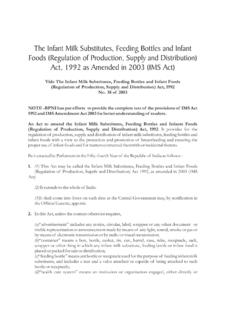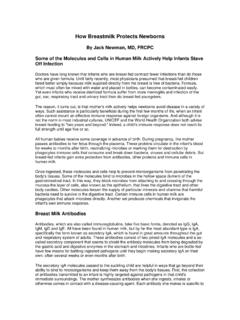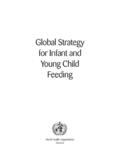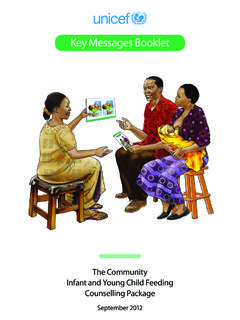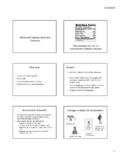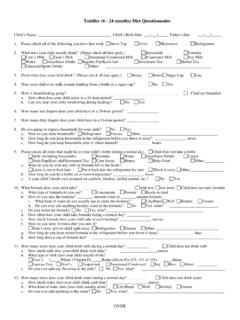Transcription of Countermarketing and the International Code
1 Countermarketing and the WHO International Code Definition Countermarketing addresses the marketing by commercial com-petitors (makers or distributors of infant formula) that has a neg-ative effect on breastfeeding by seeking to limit these companies use of competing imagery and influences in the media and in health settings. Countermarketing differs from social marketing because it is specifically directed at commercial enterprises that compete against breastfeeding and other factors known to have a negative impact on breastfeeding. The World Health Organization (WHO) International Code of Market-ing of Breast-Milk Substitutes, adopted in 1981 by the World Health Assembly,57 is a comprehensive set of guidelines for those who work and interact with mothers and infants that suggests standards for the appro-priate marketing and distribution of commercial competitors to breast-feeding ( , makers of infant formula).
2 It is generally referred to as the International Code. Rationale Widely prevalent advertising, imagery, and promotions such as free offers, endorsements, and direct mail have been successful in increasing product recognition and sales for many commercial organizations. The commercial marketing of infant feeding products has been shown to have a negative impact on Limiting the marketing of commercial compet-itors who compete with breastfeeding can help mothers and families make appropriate and informed decisions about infant feeding. The International Code provides standard guidelines for the marketing and distribution practices of commercial competitors to breastfeeding, especially to limit marketing directed toward pregnant women and new mothers. WHO and UNICEF, through the World Health Assembly, determined the International Code was necessary in view of the vulnerability of infants in the early months of life and the risks involved in inappropriate feeding practices, including the unnecessary and improper use of breast-milk sub-stitutes.
3 These organizations further decided the marketing of breast-milk Countermarketing and the WHO International Code 35 substitutes requires special treatment, which makes usual marketing practices unsuitable for these products. ( International Code, p. 7) Evidence of Effectiveness The Cochrane review of the impact of distributing samples of infant for-mula and promotional materials to breastfeeding mothers in the form of hospital discharge packs suggests a negative effect of this direct marketing on the duration and exclusivity of This review included nine randomized controlled trials involving a total of 3,730 women in North America. These studies evaluated the impact of both distributing free samples of infant formula and giving out promotional materials on infant formula to new mothers who were already breastfeeding.
4 The main outcome measures were (1) breastfeeding at 6 and 13 weeks postpartum, (2) the prevalence of exclusive versus partial breastfeeding between 0 and 13 weeks postpartum and at 6 months, and (3) the timing of the introduc-tion of solid food. The main finding was that when compared with not giving a discharge pack or providing a noncommercial discharge pack, dis-tributing samples of infant formula reduced exclusive breastfeeding at all time points measured. No detrimental effects were found when discharge packs of commercial infant formula were not distributed. In addition to the negative impact of distributing samples of infant formula during the mother s hospital stay, Howard et demonstrated in a randomized controlled trial of 547 women that educational materials on breastfeeding produced by manufacturers of infant formula and distributed to pregnant women intending to breastfeed had a substantially negative effect on the exclusivity and duration of breastfeeding.
5 This impact was much greater on women with uncertain or short breastfeeding goals. The effect of the marketing practices of commercial competitors on breastfeeding is of particular concern because of its disproportionately negative impact on mothers in the United States who are known to other-wise be at high risk for early termination of breastfeeding, including those who are primiparous (first-time mothers), have less formal education, are nonwhite, or are ill 36 The CDC Guide to Breastfeeding Interventions Description and Characteristics The International Code individually addresses the roles of health care systems, health workers, and persons who manufacture, mar-ket, and distribute products that compete with breastfeeding. The International Code also covers issues of labeling, quality, and moni-toring compliance with the guidelines.
6 Commercial competitors are those who manufacture or distribute infant formula, foods, and beverages intended for infants less than 6 months old, as well as feeding bottles, arti-ficial feeding teats, pacifiers, and other products that support or promote bottle feeding. The International Code aims to contribute to the provision of safe and adequate nutrition for infants, by the protection and promotion of breast-feeding and by ensuring the proper use of breast-milk substitutes, when these are necessary, on the basis of adequate information and through appropriate marketing and distribution. 57 The International Code recommends No advertising of breast-milk substitutes directly to the public. No free samples to mothers. No promotion of products in health care facilities. No commercial product representatives to advise mothers.
7 No gifts or personal samples to health workers. No words or pictures idealizing artificial feeding, including pictures of infants on the products. The International Code also states Information to health workers should be scientific and factual. All information on artificial feeding, including the labels, should explain the benefits of breastfeeding and the costs and hazards associated with artificial feeding. Unsuitable products, such as condensed milk, should not be promoted for babies. All products should be of a high quality and take into account the climatic and storage conditions of the country where they are used. Until the late 1980s, infant formula was not marketed directly to consum-ers in the United States. Instead, marketing efforts focused on the rela-tionship between health professional and parent in making decisions Countermarketing and the WHO International Code 37 about infant feeding.
8 Over the last two decades, however, there has been a movement toward using direct-to-consumer marketing instead of adver-tising to physicians and other health professionals who might influence parents decisions about infant This change has made it more challenging for health care systems and health workers to comply with the International Code. Two major aspects of the challenge in complying with the full International Code in the United States involve reconciling seemingly opposing needs. To some, the concepts and recommendations put forth in the International Code conflict with legislation about free-dom of speech, including advertising. A further compli-cation is the limited regulation of product label claims within the United States. The first challenge notwith-standing, individual health care systems, health workers, and media organizations can choose to provide venues (such as clinics, pediatrician offices, and WIC locations) for distributing code-compliant information.
9 Program Examples The Ohio Department of Health and Linda Smith have published materials to assist states, health departments, hospitals, and individu-als in evaluating breastfeeding materials. A score sheet for evaluating breastfeeding materials ( , pamphlets, audiovisuals, posters, handouts, other media) is available to help determine whether they comply with International Code guidelines. The National WIC Association has published a document about the role of infant formula in WIC. This document may be ordered directly from the National WIC Association (call 1-800-231-4385 or visit [select Products]). The National Alliance for Breastfeeding Advocacy (NABA) represents the International Baby Food Action Network (IBFAN) and the World Alliance for Breastfeeding Action (WABA) in the United States.
10 NABA s mission is to pro-tect, promote, and support breastfeeding in the United States, and it uses various efforts to advocate for breastfeeding as the cultural norm. NABA Research Education Advocacy and 38 The CDC Guide to Breastfeeding Interventions Legislation (NABA REAL) is the nonprofit organization responsible for monitoring compliance with the International Code in the United States. NABA REAL trains others in monitoring compliance and main-tains a Code Help Center to assist others in reporting violations of the International Code. NABA publishes and distributes documentation of International Code violations in the United States. Potential Action Steps Provide noncommercial posters and educational materials on breastfeeding to the offices of pediatricians, family practitioners, obstetrician-gynecologists, and nurse-midwives to be used in place of similar materials provided by commercial manufacturers.










